Carole Ann Klonarides and Michael Smith have been friends since collaborating on his videotape and installation, It Starts At Home. Klonarides interviewed Mike over barbecue at Meyer’s Elgin Smokehouse while visiting Texas for the opening of his retrospective, Mike’s World at the Blanton Museum of Art in Austin. Mike’s World, on view at the Blanton through December 30, will travel to the Institute of Contemporary Art, in Philadelphia (April 24-August 3, 2008).
CK: Would you define yourself as a performance artist?
MS: Well, I still perform occasionally and I perform in my videos, so I guess I am—but I’m not the typical performance artist.
CK: Do you think coming from Chicago had any influence on your performance art?
MS: Oh sure, there’s a whole tradition of comedy from there—I think Bob Newhart came from Chicago–it bred a particular “deadpan” comedy. I grew up when comedy records were brand new.
CK: You like the stand-up comic Jackie Vernon, right? Wasn’t he known as the “King of Deadpan”?
MS: He was great, yeah. I remembered him from watching Ed Sullivan or some other variety shows as a kid. My delivery was very much influenced by him as well. His voice and delivery stayed in my head. I was also influenced by 50s kid shows and other stuff from my youth.
CK: You’ve been called the “Ed Sullivan and Mr. Rogers of the art world”…
MS: Yeah, flattering comparisons. Even my installations and videos—these kind of very real environments as sets, these mockumentaries—are also compared.
CK: Mockumentaries—like “Spinal Tap” or “Real Life”?
MS: Yeah.
CK: You started out painting, but you just don’t strike me as a person that would be involved in a solitary practice.
MS: At one time I was but now, no. After collaborating and doing this big show at the Blanton Museum, which is all about collaboration, the idea of being alone is really very appealing. I do drawings, and I enjoy being at my desk and developing the ideas—the development part of the process—it’s when you have to produce the ideas that it gets painful.
CK: Is that why you seek out collaborators, to help facilitate production?
MS: Yeah.
CK: And how do you find your collaborators?
MS: It depends. First of all they have to be willing. And hopefully I work with people who are challenging.
CK: When we first met in the late 70s, you were interested in creating a cable show on local access and you were putting together a group of individuals who you had hoped would be the production crew of this ongoing project. They were all different kinds of people—musicians, painters and writers—but all funny people. I remember Barbara Kruger, Eric Fischl, Susan Davis, and Randy Cohen (who is now the New York Times Ethicist), as being involved with the group.
MS: I guess you could call it a think-tank.
CK: It was like an art think-tank!
MS: I was very naïve. I equated public access with a series—you get an idea and you do it. But I learned very quickly that a production on that scale is a lot of work.
CK: Well, you did create a videotape and installation out of the effort called It Starts at Home (1982).
MS: Yeah, but when we shot the production it boiled down to a handful of people. Almost everyone was busy with his or her own projects.
CK: It Starts At Home was centered on the everyday life of your character “Mike,” who has remained the mainstay of your art practice to present day—has Mike changed?
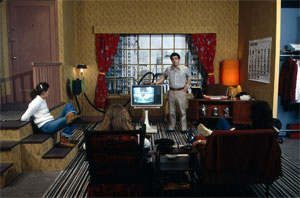
”Mike's House,” 1982...Installation fragment with videotape “It Starts at Home”...Dimensions variable...Courtesy the Artist
MS: Well actually, I started with him in his underwear and he’s still in his underwear. I think he has remained as originally conceived; he stays pretty much the same but exists in different environments and different situations. When I was first figuring out who he was I was very interested in slow, deliberate timing which is not how I normally act—even though I can be slow and deliberate, I am a little quicker and more anxious. Maybe not quick, but anxious! I was looking to make Mike kind of generic. I was also fascinated with the idea of sales, which probably explains my fascination with Dale Carnegie. I am sure my father, who was in real estate, was a huge influence, especially his obsession with time and his interest in gadgets. Everything broke in my father’s world, except his relationships. I’m a reactive person; Mike is a follower. I react to things around me, and that’s where I get a lot of my ideas.
CK: Why did you need to express your ideas through a character?
MS: I don’t know if it was a need, it was just a way to tackle narrative and it just sort of happened that way. It came out of working on my timing, vocalizing and talking. I was in the center of it, so I became the character. It’s also about everyday things, and he’s my vehicle.
CK: How did Mike develop? One of the things I’ve noticed is that he is an amalgam of many different characters—some real people; some imaginary. For instance, you’ve talked a lot about actors Buster Keaton and Jacques Tati as being influences on you.
MS: The Mike character developed very organically. He originally came out of this idea of blandness. I was interested in something very neutral, something very bland. Tati and Keaton were pros at deadpan. They were both very visual. I was amazed at how they orchestrated scenes. My scenes are not that spectacular; they’re much flatter. I responded to them, they made me laugh. It was also very new to me then. I was slowly building the character as I was learning. It was exciting.
CK: Both Buster Keaton and Jacques Tati were kind of “everyman” characters who created humor in the situations they found themselves in and their reactions to them. But Mike is oblivious to his situation, and focuses more on the minutia of everyday life.
MS: I’m very detail-oriented. Working with various people like Alan Herman (an installation artist who works commercially as a set designer) and Joshua White allowed me to expand on this even more. Alan is an incredibly talented designer who also happens to be very detail-oriented, and whose sensibility happens to dovetail nicely with my work. I work with everyday items, like a sculptor works with materials.
CK: I first worked with you in the making of the videotape Secret Horror (1980). I always felt Secret Horror was about your face and your height. It starts out as a nightmare where the drop ceiling is falling on Mike, and then Mike throws a party where only ghosts who are taller than him attend! It’s really a non-vertical narrative except for the music.
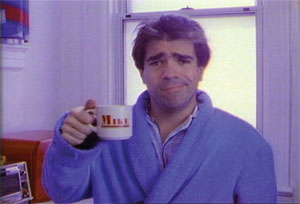
“Mike,” 1987...16 mm film transferred to video...2'43 minutes...Courtesy Michael Smith and Electronic Arts Intermix
MS: As for my face, I do use it a lot but the use of close-ups was the direction of Mark Fisher, the collaborator on many of my early videos. Tall people towering over Mike gave them a presence and created a feeling of awe in Mike. Maybe it was about my height. I was clueless when I went into shooting it—it was my first video and Mark Fischer walked me through the scenes and set up most of the shots. For me, a big part of the video was the music; it was about the ambiance. I was looking for a general kind of homogeneous, bland ambiance to run through the entire tape. The piece was inspired by a trip to my bank in Manhattan, a beautiful old bank that bit the dust. One day I came in and it was completely renovated—they dropped the ceiling, covered up all the beautiful detailing—and so the video was a transposition of this experience. And then I started thinking of muzak culture and the horrors associated with blandness and so on.
CK: But there’s also the nightmare, the reality of not being popular, or not sending the invitations out to your own party, or being found in your underwear, or having an ink stain on your pocket…
MS: These are pretty basic fears, really.
CK: Why did you focus on those fears?
MS: Without getting too psychological, I…
CK: You can get psychological!
MS: I don’t know if I can, I don’t know if I can go that deep. At first they were story devices. They were a way to victimize him and make a joke at his expense. When I started doing what I do I didn’t want the humor to be at the expense of someone else, I wanted it to be at the expense of my character and/or me.
CK: Well, Mike seems to find himself in these psychological kinds of situations where most of us have these fears, like being found in just your underwear or having a party that nobody shows up to.
MS: These are very basic, almost childish—I mean they’re very undeveloped kinds of fears. They’re not that nuanced.
CK: But they are a continuing theme in your work. They do pop up from time to time.
MS: Yes, that becomes more evident in my survey exhibition. Mike is fairly consistent—same guy with the same dreams.
CK: In It Starts at Home Mike’s talent agent is an animated “fur ball” named Bob. I always thought of Bob as one of your eyebrows!
MS: My mother gave me a fur toy she made for her cat. Somehow it became Bob.
CK: You also wear outfits made out of fur when you perform your dirty songs…
MS: You’re right, more fur. I needed a stupid-looking outfit and I had this piece of fur, so I attached some zippers and called it an outfit. And then I found this stupid hat and this Elks Club satin yoke and put that around my neck, and soon it became this incredibly stupid-looking assemblage of dumb-looking shit. A lot of it I found on the street or in thrift stores. I guess I made myself into some sort of stuffed animal.
CK: You always used a lot of junk from the street.
MS: Yeah, I stopped doing that. I moved on.
CK: Like many artists who made video in the 80s, you had this fantasy that your work would be on television and reach a large audience.
MS: I don’t have that fantasy anymore. However, after a long hiatus I made a video again–I just made Portal Excursion, (2006); it’s a single-channel 10-minute video.
CK: And how is it to be distributed, is it just shown?
MS: Actually, it’s going to be in the Whiney Biennial. When this piece is shown with my previous works it starts to resonate a lot more, it’s interesting. It’s also interesting to see Portal in relation to Secret Horror. Both are these journeys, these passages, and in both videos, Mike comes out of the experience OK. Whether or not he changes, well that’s not the point.
CK: You also produced an orientation video for your survey exhibition (in collaboration with Josh White) that helps the viewer enter the world of Mike.
MS: The orientation video was produced to create a familiarity with the character. Who is Mike? It seems pretty clear. I mean, why Mike? Like I said, he is my vehicle and I happened onto him organically. And the material is a pastiche of many influences: television, sit-coms, art, the art world, sales and sales tapes. I guess I have a particular interest in sales, selling an idea, selling something to people. A lot of the American Dream seems to be about selling⎯politicians sell slogans; politicians figure out the demographic and then they hone in on it. In the 80s I reacted to Reaganomics. It was hard for me to accept the Reagan message as sincere. I always projected a cynicism onto it. So in a way, I was just representing what they were serving up to the American population.
CK: It seems that what you’re describing is the mass marketing of Mike to the art museum-going demographic. Ironically, though, Mike is a follower who gets tangled in a quagmire that never takes him where he wants to go. He always seems to end up in this “Mike space” that’s somewhat bittersweet. There’s a loss of innocence and optimism, even though Mike stays the same.
MS: Right, you’re sold something but there’s not necessarily a guarantee to what you get. Whether it be a dream or a product, you have to figure it out for yourself, and Mike doesn’t always figure it out. He gets to a point where he hasn’t necessarily reached where he wanted to go, but he moves on anyways. Mike bounces back; he’s trying to get his piece of the pie but then he gets distracted He bounces back again. Mike sees the glass half full, I see it half empty. He stays hopeful.
CK: Is that why you did the performance where you drink unbelievable amounts of water?
MS: Well the water-drinking piece actually came out of a real life story. I heard this alcoholic tell an incredibly dull story over and over again; it was about drinking water. She woke up thirsty one morning and she told the story as if it was a revelation—I retold it with some embellishments.
CK: And also the fact that the audience has to endure the tension of you drinking all of this water while you are physically enduring it…
MS: I was working with the idea of entertainment, but trying to push it. The comic Andy Kaufmann was doing the same thing. I was talking to my sister the other day and she said she remembered when I did “100 Bottles of Beer on the Wall” in Chicago around 1974 or ‘76. I read somewhere that Kaufmann did the same routine. I didn’t push it as much or as successfully as him. I was more interested in fitting in or seeping in between the cracks.
CK: It was also the time of Minimal art, and the beginning of artists, in particular conceptual artists, using some humor and irony in their work.
MS: Right, also artists slipping into the media—television.
CK: I think a lot of artists of our generation didn’t want to be defined, so they created hybrid art forms that were then called “cross-over” art or “new genres”.
MS: I was very interested in the idea of crossing over but not so much anymore–I don’t put my energy there.
CK: I think there was a group of artists who were really interested in not being defined, period.
MS: Right. Maybe it was out of my own ignorance, but I reacted to a certain tone in the art world.
CK: Are you taking about the reverent tone?
MS: Yeah, a serious reverent tone. There is always some feeling of reverence in certain sectors of the art world, possibly more so back then. My work was sometimes dismissed, which in a way gave me a certain kind of empowerment.
CK: Well, speaking of reverence, you’ve got a survey up, and you actually had to recreate some of these sets which have long since been destroyed—how did that feel?
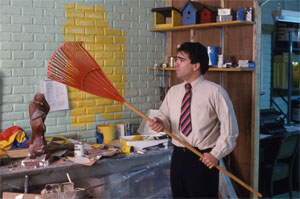
Michael Smith and Alan Herman...“Government Approved Home Fallout Shelter/...Snack Bar,” 1983...Photo Credit: Kevin Noble
MS: A pain in the ass! Honestly, very good. I’m very glad they’re up. I mean, it was a drag to schlep that stuff back then but now I wish I’d kept it. A couple of the pieces are different from what they were like originally. I had to approximate many of the props and objects. Fortunately, I kept many of the key items–I tried to recreate the video game for the fallout shelter but it was more than I could handle at the time.
CK: It’s outdated technology probably, you can’t even find them anymore really. It never worked anyway!
MS: No it worked, off and on, but it was kind of boring…
CK: Well, it was a game that always had the same outcome, let’s put it that way.
MS: Yeah well that was the idea. It was programmed to lose. Like nuclear war.
CK: It was interesting to see some of the pieces again, it just brought back a lot of memories. We age, but the character, even though he physically changes and is in different situations, he seems to never quite get it. He stays the same.
MS: Isn’t that wonderful?
CK: Actually it’s depressing. It’s really kind of depressing.
(Both laugh)
CK: Speaking of depressing, the MUS-CO, (1997/2007) installation reminded me of so many dreary places I’ve visited over the years. I just look at these places in awe that somebody actually goes there day in, day out and works there.
MS: It can become a kind of clubhouse. Artists go to their studio. I go to my studio and sit at my desk waiting for something to happen. There could be periods where nothing was happening and yet I kept going back. My father would return to his office day in and day out and yet there was nothing happening there. It was incredibly poignant to witness. Going to the office was part of his daily routine.
CK: Do most of the pieces serve as kind of a metaphor for you of the art world and being an artist in today’s world?
MS: Yes and no. More recent work definitely reflects that. It Starts at Home and the fallout shelter, no. But with MUS-CO, and QuinQuag, (2001-2002) definitely–I made a concerted effort to get back into the art world around the mid 90s and these pieces reflect my experience; they’re cloaked in another kind of language and put in another kind of context. And then there’s Openhouse, (1997/2007) where I made myself an artist. That is much more overt.
CK: Do you think the work is existentialistic?
MS: Well, Mike operates in a vacuum and is always looking for something, I don’t know if it’s meaning but he’s looking for something. For direction, most likely.
CK: He doesn’t really seek it out with relationships.
MS: No. I mean that’s one thing Josh White always wanted to do, he wanted to bring in people and relationships. There are people in the pieces that I’ve worked with him on, but even in those it seems that Mike’s still pretty off on his own kind of tangent.
CK: What about the Take off your Pants (TYOP), (2005) piece? Josh said he thought that goes to a darker place than the other pieces. Do you feel that way?
MS: Well, it’s more unsettling because it’s not as resolved. I wanted to go back to an original way of constructing a narrative; a container of disparate ideas, like Secret Horror. I had this idea for this game and juxtaposing it with the Internet. It doesn’t necessarily make immediate sense. Maybe that’s disturbing, that it’s not totally wrapped up or packaged. There’s this undercurrent of paedophilia but in all of the writing about it, there hasn’t been any mention of this. I think it’s true for a lot of people; they are sitting at home in their underwear, at their computer. It’s an isolating activity. It doesn’t quite add up, especially when you hear a lot of talk about a “network” of people connecting.
CK: It’s funny, that was the only piece that really reminded me of Mike Kelley. Because of this idea of something that’s supposed to be for children but is actually for adults.
MS: Well I did do a kiddie show and a musical with children actors. But after doing both I realized I was not interested in children, but rather in juvenile humor for adults. I guess the humor in TOYP is kind of disturbing.
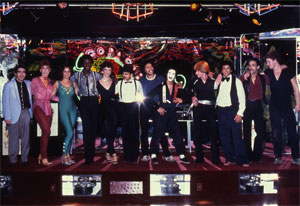
Michael Smith and Joshua White...The USA Freestyle Disco Championship, 1979/2003...Slide show with music and graphics...Courtesy the Artist, Ellen...de Bruijn Projects, Amsterdam and...Dunn and Brown Contemporary, Dallas...Photo credit: Kevin Noble
CK: I like that it’s installed next to MUS-CO, reflecting into the musical production room, the disco room, because discos are kind of like adult amusement parks. Josh White used his experience as a lighting and set designer to help plan out the exhibition. He has worked with you over the years and has a sophisticated understanding of what you’re about. How did the curator Annette DiMeo Carlozzi plan the show–did she have a say in terms of how pieces were installed?
MS: Annette had a huge say about what would be in the show and not be in the show, but Josh and I designed it. It was her idea to focus on the Mike character, and that was discussed from the beginning. Much of the discussion was about whether the work was Mike or Michael Smith. Annette was very clear and consistent about this. She even insisted we do it for the bio—it’s all related to Mike, performances or appearances or Mike-related work.
CK: What are you going to do now that the show is up?
MS: I guess I have enough to do; Doug and I are remounting the puppet show for a large puppet exhibition at the ICA that Ingrid Schaffner and Karin Kuoni are curating. I will be performing at the Biennial. I also have a show at Hales Gallery in London late this spring. After that I will probably go into a huge hole.
CK: Is there any medium you haven’t worked with? You haven’t built a house; you haven’t done architecture yet?
MS: I have a dumpster idea…
(Both laugh)
CK: Didn’t Gordon Matta Clark do something with a dumpster?
MS: Damn it!
CK: Where’s the exhibition going after Austin?
MS: Philadelphia. In spring. I don’t know what’s happening to it after that; I think it’s going to be coming back to Mike’s house.

Carole Ann Klonarides is an independent curator and instructor of contemporary art living in Los Angeles. She is currently a consultant at the Getty Research Institute, interviewing artists from the Long Beach Museum of Art Video Collection, which was recently acquired by the Getty. Klonarides was formerly the Curator of Programming at the Santa Monica Museum of Art and Media Arts Curator at the Long Beach Museum of Art.


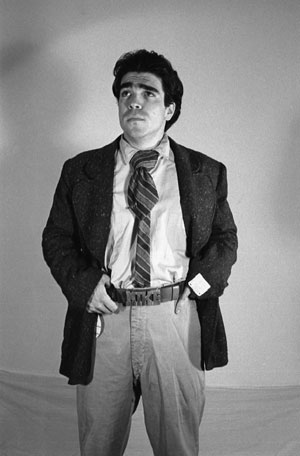




0 comment
pics from the Nexus Texas opening!
http://seanmorrisseycarroll.blogspot.com/2007/08/nexus-texas.html